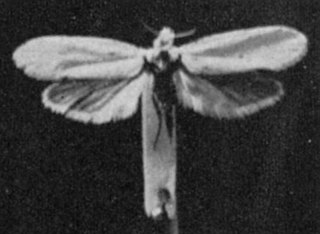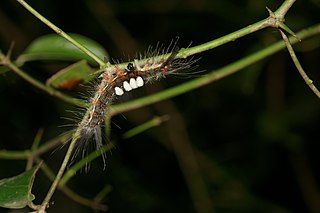
The Salicaceae are a family, the willow family, of flowering plants. The traditional family included the willows, poplar, aspen, and cottonwoods. Recent genetic studies summarized by the Angiosperm Phylogeny Group have greatly expanded the circumscription of the family to contain 56 genera and about 1220 species, including Scyphostegiaceae and much of the former Flacourtiaceae.

The Pterophoridae or plume moths are a family of Lepidoptera with unusually modified wings. Though they belong to the Apoditrysia like the larger moths and the butterflies, unlike these they are tiny and were formerly included among the assemblage called "microlepidoptera".

The Tortricidae are a family of moths, commonly known as tortrix moths or leafroller moths, in the order Lepidoptera. This large family has over 10,350 species described, and is the sole member of the superfamily Tortricoidea, although the genus Heliocosma is sometimes placed within this superfamily. Many of these are economically important pests. Olethreutidae is a junior synonym. The typical resting posture is with the wings folded back, producing a rather rounded profile.

Oecophoridae is a family of small moths in the superfamily Gelechioidea. The phylogeny and systematics of gelechoid moths are still not fully resolved, and the circumscription of the Oecophoridae is strongly affected by this.

The Gelechiidae are a family of moths commonly referred to as twirler moths or gelechiid moths. They are the namesake family of the huge and little-studied superfamily Gelechioidea, and the family's taxonomy has been subject to considerable dispute. These are generally very small moths with narrow, fringed wings. The larvae of most species feed internally on various parts of their host plants, sometimes causing galls. Douglas-fir (Pseudotsuga) is a host plant common to many species of the family, particularly of the genus Chionodes, which as a result is more diverse in North America than usual for Gelechioidea.

The Prodoxidae are a family of moths, generally small in size and nondescript in appearance. They include species of moderate pest status, such as the currant shoot borer, and others of considerable ecological and evolutionary interest, such as various species of "yucca moths".

Notodontidae is a family of moths with approximately 3,800 known species. Moths of this family are found in all parts of the world, but they are most concentrated in tropical areas, especially in the New World. The Thaumetopoeidae are sometimes included here as a subfamily.

The Lymantriinae are a subfamily of moths of the family Erebidae.

Coleophora is a very large genus of moths of the family Coleophoridae. It contains some 1,350 described species. The genus is represented on all continents, but the majority are found in the Nearctic and Palaearctic regions. Many authors have tried splitting the genus into numerous smaller ones, but most of these have not become widely accepted.

Gracillariidae is an important family of insects in the order Lepidoptera and the principal family of leaf miners that includes several economic, horticultural or recently invasive pest species such as the horse-chestnut leaf miner, Cameraria ohridella.

Carposinidae, the "fruitworm moths", is a family of insects in the order Lepidoptera. These moths are narrower winged than Copromorphidae, with less rounded forewing tips. Males often have conspicuous patches of scales on either surface. The mouthparts are quite diagnostic, usually with prominent, upcurved "labial palps", the third segment long, and the second segment covered in large scales. Unlike Copromorphidae, the "M2" and sometimes "M1" vein on the hindwings is absent. The relationship of Carposinidae relative to Copromorphidae needs further investigation. It is considered possible that the family is artificial, being nested within Copromorphidae. The Palearctic species have been revised by Alexey Diakonoff (1989).

Choreutidae, or metalmark moths, are a family of insects in the lepidopteran order whose relationships have been long disputed. It was placed previously in the superfamily Yponomeutoidea in family Glyphipterigidae and in superfamily Sesioidea. It is now considered to represent its own superfamily. The relationship of the family to the other lineages in the group "Apoditrysia" need a new assessment, especially with new molecular data.

The Batrachedridae are a small family of moths. These are small, slender moths which rest with their wings wrapped tightly around their bodies. The taxonomy of this and related groups is often disputed. It was long thought to contain two genera, Batrachedra and Houdinia.

The Saturniinae or saturniines are a subfamily of the family Saturniidae. They are commonly known as emperor moths or wild silk moths. They are easily spotted by the eyespots on the upper surface of their wings. Some exhibit realistic eye-like markings, whilst others have adapted the eyespots to form crescent moon or angular shapes or have lost their wing scales to create transparent windows. They are medium to very large moths, with adult wingspans ranging from 7.5 to 15 cm, in some cases even more. They consist of some of the largest groups of Lepidoptera like the moon or luna moth, atlas moth, and many more. The Saturniinae is an important source of wild silk and human food in many different cultures.

The Ludia's shrew is a species of mammal in the family Soricidae. It is found in Cameroon, Central African Republic, Republic of the Congo, and Democratic Republic of the Congo. Its natural habitat is subtropical or tropical moist lowland forests. It is threatened by habitat loss.
Blastobasis kenya is a moth in the family Blastobasidae. It is found in Kenya. The habitat consists of coastal lowlands, eastern midaltitudes and the western highlands.
Pardosa ludia is a species of spider in the genus Pardosa, family Lycosidae. It is endemic to Myanmar. It was described for the first time by Thorell, in 1895.















